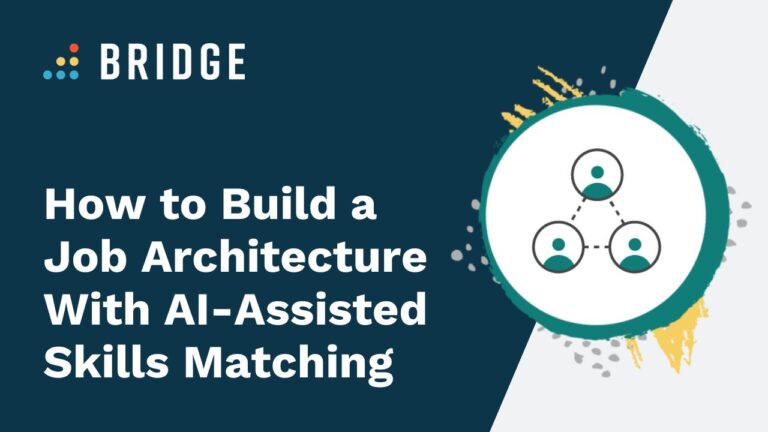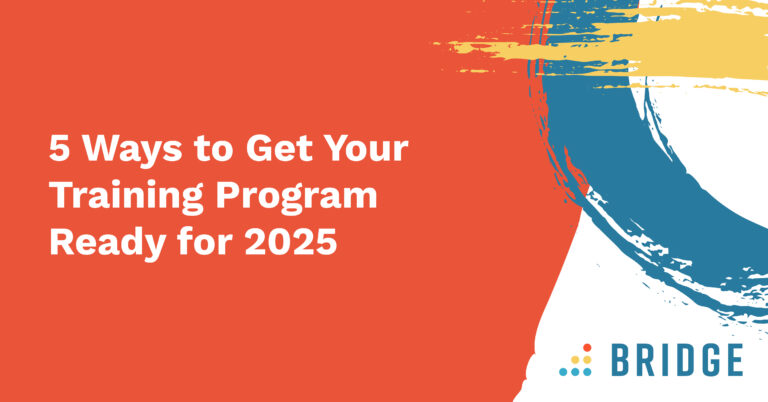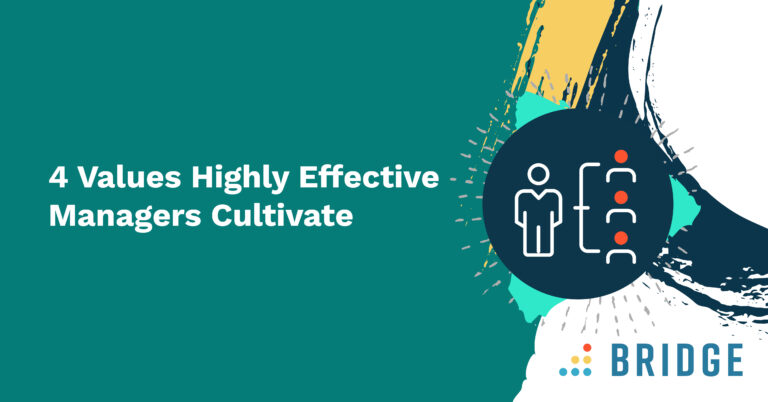No matter how adept your employees are at their current roles, it’s always important to offer them an extra degree of dynamism. What if continuous upskilling and reskilling left them more capable of adapting to unexpected business needs? That’s the power of a well-crafted job architecture—a framework for structuring job roles that enhances employee development, empowers talent mobility, and provides your organization with a degree of agility that’s never been more essential.
In fact, according to a report from the Business Agility Institute, business agility efforts are responsible for organizations: management system:
- Coping with volatility
- Achieving stronger commercial outcomes
- Improving employee engagement
There’s no question that job architectures have a part to play in achieving these agility-driven outcomes. As the report notes, internal skill development is a key component of business agility, especially against a backdrop of skilled worker shortages—and, as luck would have it, skill development is exactly what a job architecture promotes.
Operating in tandem with a talent platform, your job architecture will allow your people to recognize and work toward the skills they’ll need for new internal opportunities. In turn, you’ll quickly create a culture of development that will help your people to meet organizational needs and fill skills gaps as they arise.
While agility improvements are already a fantastic incentive, they’re far from the only advantage associated with job architectures. Read on to discover how the right approach to defining job families and levels can have enormous implications for wellbeing, inclusivity, and employee retention.
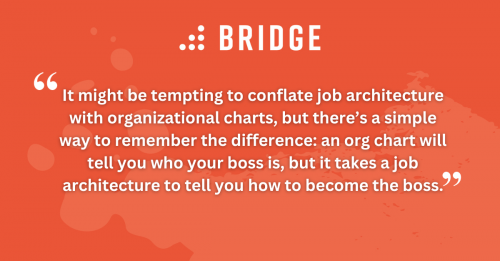
What Is a Job Architecture?
Perhaps the best way to define job architecture is to think about the way you might use it.
If your employees want to progress within your company, whether in an upward or a lateral direction, they’ll want to know what skills their next job requires. Or, if they’re not sure what their next job should be, they’ll want recommendations for jobs with similar skill requirements to their current position, allowing them to move in the right direction.
Job architectures facilitate the process of internal mobility by lending structure to your organization’s various job roles. They define each role in terms of the scope, responsibilities, and—crucially—skills involved. They also establish the hierarchical relationships between each position and form family frameworks around jobs that involve similar skills and experiences. A skills platform can use this information to recommend internal jobs and career paths to the employees best suited to each role, pairing job-related skills data with information on your own employees’ skillsets.
It might be tempting to conflate job architecture with organizational charts, but there’s a simple way to remember the difference: an org chart will tell you who your boss is, but it takes a job architecture to tell you how to become the boss.
MORE FROM THE BLOG | ‘How Org Charts Can Help Workplace Mentorship Programs’
What Can Your Organization Achieve With a Job Architecture?
As mentioned above, the primary benefit of job architecture is improved internal mobility. In conjunction with a talent platform, your architecture can offer your people a structured pathway for ongoing career development. It achieves this by giving them a sense of the skills and experiences they’ll need on their journeys. As such, the advantages a job architecture offers are many and varied—both within and beyond the world of mobility.
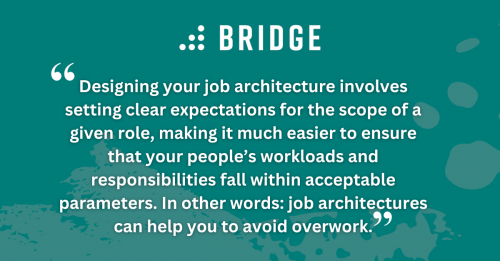
Improved Employee Retention
As a key part of your mobility machine, job architecture acts as a gateway to improved employee retention. Given that the average 20 to 24-year-old worker in 2022 had a median tenure of 1.2 years per employer, there’s clearly an increasing need to convince staff that they don’t need to leave your organization to advance their careers or retain control over their next steps. That’s where the internal mobility your architecture facilitates can really shine.
MORE ABOUT MOBILITY | ‘The 5 Pillars of a Successful Talent Mobility Strategy and How to Leverage Them’
In-Depth Succession Plans
Job architectures don’t just inform the progression plans of individual employees—they’re also great for forming succession plans. You’ll become more effective at identifying and preparing individuals for critical roles when you have a firm grasp of the skills required to fill those roles, and a job architecture is the perfect framework for providing that information.
Bolstered Employee Wellbeing
Even when you put internal mobility to one side, a well-constructed job architecture offers a wealth of incentives for sticking with your organization. Take job descriptions, for example. Designing your job architecture involves setting clear expectations for the scope of a given role, making it much easier to ensure that your people’s workloads and responsibilities fall within acceptable parameters. In other words: job architectures can help you to avoid overwork, ensuring that your employees are less likely to find themselves in the 48% that Microsoft found to be burnt out in a 2022 study.
GET WELLBEING INSIGHTS | ‘How to Boost Employee Wellbeing in the Workplace’
Effective Promotion of Equal Opportunities
Similarly, your job architecture’s emphasis on skills and experience can only serve to level the playing field for ambitious employees. Putting skills at the heart of your approach to promotions and lateral moves can further your commitment to equal opportunities by shifting focus away from demographic factors like age, gender, race, and so on. As a moral obligation, this advantage really speaks for itself—but it also doesn’t hurt to know that any steps toward enabling the best talent to shine enhances innovation, productivity, and your bottom line.
4 Key Steps Toward Defining Your Job Architecture
As a detailed framework of your organization’s various job roles, job architectures are structured around a handful of important components. They all play a part in ensuring your employees have the progression-related knowledge they need at their fingertips—so you’ll need to make sure you take the following steps as you bring your job architecture together:
1) Establish Job Families
Starting at the top level, a job family refers to a collection of job roles. Each family is grouped together based on their shared or similar skills and competencies. They’re a great way for your employees to work out a career path that draws (and builds) upon their existing skillsets.
2) Define Job Levels
While families allow you to visualize the common ground your jobs share, job levels are more focused on organizing your job roles in terms of hierarchy. This is just as important for employees planning out their career paths, since job levels allow them to get a sense of what a more senior position might look like.
3) Align Job Titles
Once you’ve set out your job levels, you’ll want to make sure your job titles reflect those levels. This practice lends clarity and transparency to your career progression discussions and ensures your people know exactly where they stand.
4) Develop Job Descriptions
While you’re likely to encounter and create job descriptions for hiring purposes, they’ll look a little different in the context of your job architecture. Hiring managers often write summary-style job descriptions with a view to making a position look attractive, whereas your job architecture provides a far more comprehensive dive into the expectations, requirements, and duties that a given job denotes. As mentioned above, this is a great way to keep workloads healthy and responsibilities within reasonable parameters.
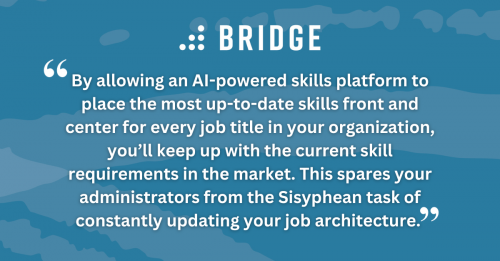
Add Comprehensiveness and Simplicity to Your Job Architecture With AI
Putting all the above elements together might feel like a daunting task—and, without the right technology at your disposal, it is. An analog approach involves time-consuming surveys, interviews, and manual analyses of job roles—followed by the painstaking process of grouping jobs into families, manually leveling those jobs, and many more similarly complex tasks.
However, with a little algorithmic boost, the process becomes a much more pleasant exercise. An AI-powered skills platform pre-populated with the skills that matter in today’s market will cut straight to the heart of the process by automatically matching job titles with relevant skills.
This isn’t a one-off advantage, either. By allowing an AI-powered skills platform to place the most up-to-date skills front and center for every job title in your organization, you’ll keep up with the current skill requirements in the market. This spares your administrators from the Sisyphean task of constantly updating your job architecture.
Crucially, when your talent system suggests skills that align with specific job roles, it’s easy to build out the key components that make your architecture tick. Identifying the patterns and connections that underpin job families is a far simpler task when the skills comprising each role are available at the push of a button.
RELATED READING | ‘What’s the Role of AI in Your Talent Management Strategy?’
Looking to Power Up Your Job Architecture With AI?
Bridge skills-first platform makes it simple to rapidly build and maintain an agile job architecture, effortlessly pairing skills to job roles while offering your people the internal positions that reflect their existing skillsets. Talk to one of our experts to discover how Bridge can close your skills gaps.
